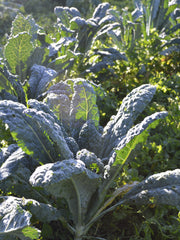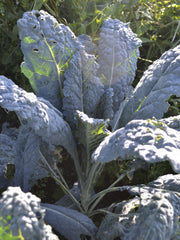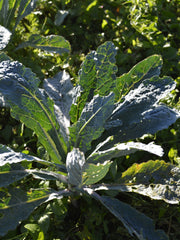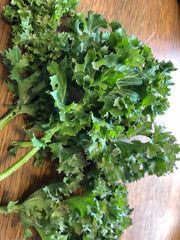Red Russian
Brassica napus pabularia
HOW TO GROW SIBERIAN KALE
Start indoors 4-6 weeks before last frost, plant out 4 weeks before frost. For fall harvest, transplant 13 weeks before first frost, without additional protection. In a hoophouse, you can plant 2-3 weeks later. Plants are hardy when small but may not feed you until spring. Direct sow anytime after last frost up to 6 weeks before first frost. For seed production, plant in late summer in the Pacific Northwest and coastal British Columbia for a more cold hardy plant. Becomes sweeter with frost and edible to about 22–25˚F. Survival at low temps 10˚F or cooler requires good mulch or snow cover to protect from wind freeze. Will cross with rutabagas. Row covers reduce cabbage worms and extend winter harvest. Soil pH 6.1-6.5. Hardiness zones 3-9. Biennial.
Days from maturity calculated from the date of seeding. Average 9,000 seeds per ounce. Average 112M seeds per acre. Federal germination standard: 75%. Usual seed life: 5 years. Isolation distance for seed saving: 1 mile.
Planting Depth 1/4-1/2”
Soil Temp. Germ. 55-75˚F
Days to Germ. 5-15
Plant Spacing 12-18”
Row Spacing 18-30”
Days To Maturity 60-70
Full Sun, Moist Well Drained
Days from maturity calculated from the date of seeding. Average 9,000 seeds per ounce. Average 112M seeds per acre. Federal germination standard: 75%. Usual seed life: 5 years. Isolation distance for seed saving: 1 mile.
Planting Depth 1/4-1/2”
Soil Temp. Germ. 55-75˚F
Days to Germ. 5-15
Plant Spacing 12-18”
Row Spacing 18-30”
Days To Maturity 60-70
Full Sun, Moist Well Drained
Red Russian Seed Count
1 Ounce ≈ 9,450 seeds
.25 Pound ≈ 37,800 seeds
- 200 Seeds$4.10
- 2000 Seeds$12.50
- 1 Ounce$26.00
- 1/4 Pound$54.00
Purple-Green oak leaf Siberian kale. Selection towards purple leaves and stems. Leaves are more tender with a milder flavor than other kales, excellent steamed or sautéed in soups, stews and pastas, diced fresh in salad. Probably the easiest kale to grow in the Pacific Northwest. Has better resistance to root rot in...
Purple-Green oak leaf Siberian kale. Selection towards purple leaves and stems. Leaves are more tender with a milder flavor than other kales, excellent steamed or sautéed in soups, stews and pastas, diced fresh in salad. Probably the easiest kale to grow in the Pacific Northwest. Has better resistance to root rot in waterlogged soils than European kale Napus kales are very winter hardy to at least 10˚F. Has better resistance to root rot in waterlogged soils than European kale. Special Selection from Nashs Organic Produce in Sequim, Washington. Also known as Ragged Jack, Canadian Broccoli, Russian Kale and Fearing Kale. Tags: Type: Siberian, Color: Purple, Heritage: Heirloom, Season: Spring Fall Winter, Certification: Organic.
Learn More
Meet Your Farmer
We promote fair trade, organic practices and environmental responsibility throughout the Restoration Seeds supply chain. Below are the family farmers and seed suppliers who bring our open pollinated seeds to you.
Saltwater Seeds
Certified Organic by WA Dept. of Ag.
Seed grower since


We are focused on growing open-pollinated seeds adapted for the Maritime Northwest. We are inspired by the endless combinations of colors, textures, flavors, and shapes of the plants we work with.As a small, diversified business, we are committed to contributing to our small-scale agricultural economy by finding, selecting, and stewarding varieties that are productive, delicious, beautiful, and well adapted to our climate.
Reviews


















